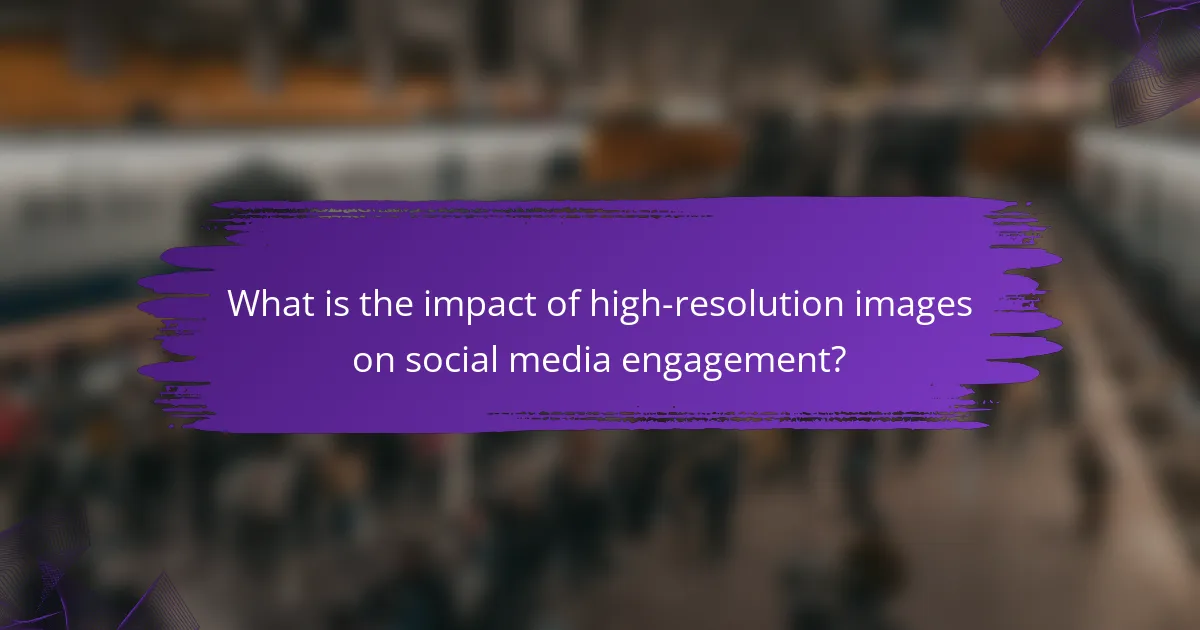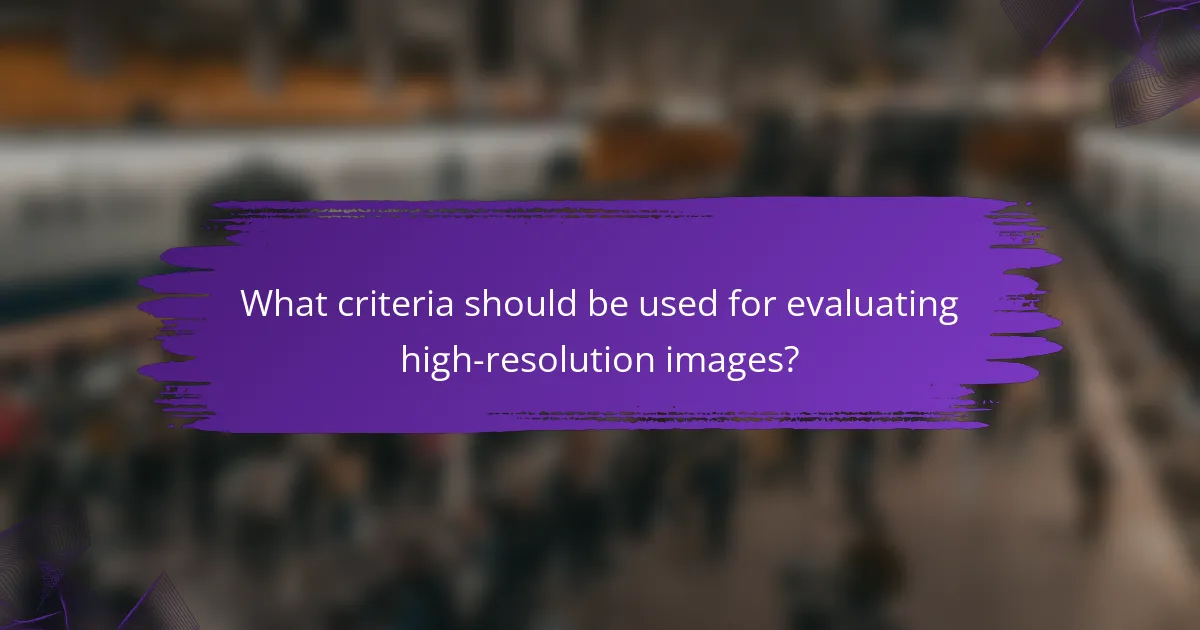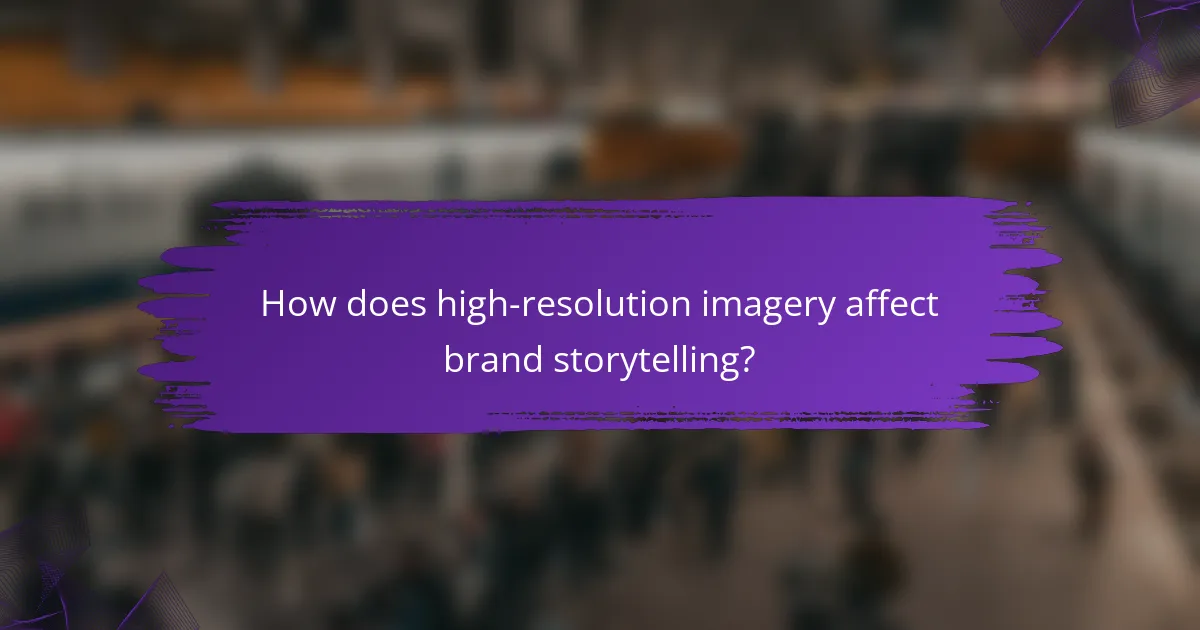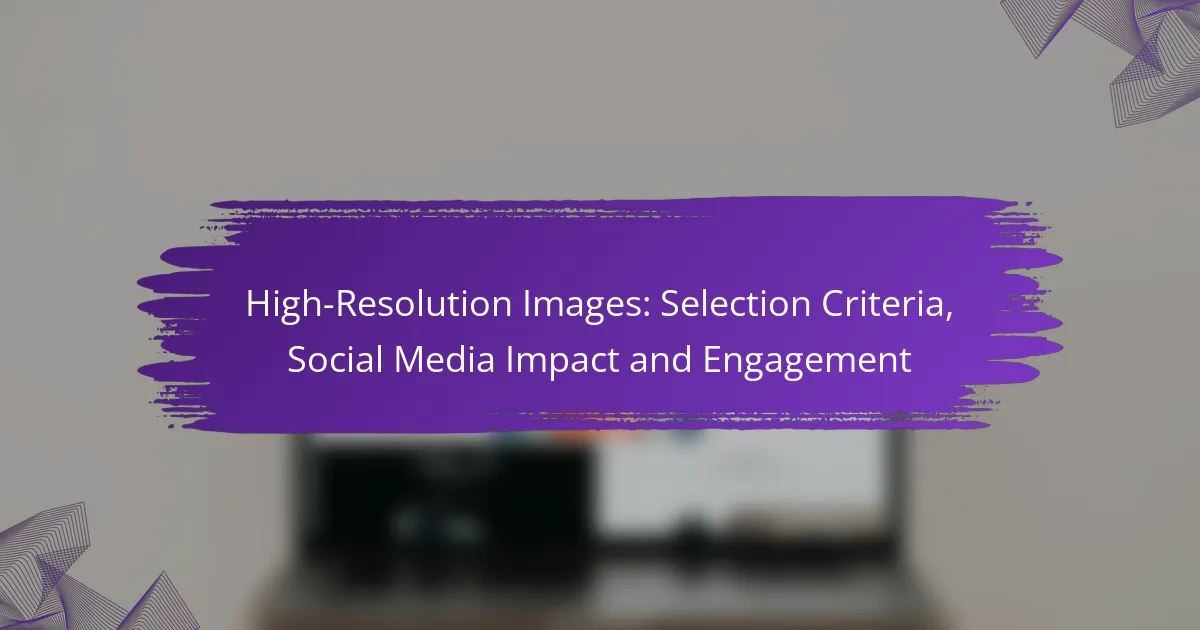High-resolution images play a crucial role in social media by enhancing clarity and visual appeal, which are essential for capturing audience attention. By focusing on image quality and relevance, brands can significantly boost engagement, leading to increased likes, shares, and comments across platforms like Instagram and Facebook.

How to select high-resolution images for social media?
Selecting high-resolution images for social media involves ensuring clarity, relevance, and visual appeal. Focus on image quality, appropriate aspect ratios, and credible sources to maximize engagement and impact.
Image quality standards
High-resolution images should typically have a minimum of 1080 pixels in width for optimal display on most social media platforms. Aim for images with sharp details and vibrant colors to capture attention and convey professionalism.
Consider using images that are at least 2 MB in size, as this often indicates better quality. Avoid overly compressed images that may appear pixelated or blurry when viewed on larger screens.
Aspect ratio considerations
Different social media platforms have specific aspect ratio requirements for images. For instance, Instagram favors a 1:1 ratio for square images, while Facebook and Twitter often use a 16:9 ratio for landscape images.
When selecting images, ensure they fit the intended platform’s dimensions to avoid cropping important elements. Tools like Canva or Adobe Spark can help adjust aspect ratios easily.
File format recommendations
JPEG and PNG are the most commonly used file formats for social media images. JPEG is ideal for photographs due to its smaller file size and good quality, while PNG is better for images requiring transparency or text.
For animated images, consider using GIFs, but be mindful of their larger file sizes and potential loading issues on mobile devices.
Source credibility
Using images from reputable sources enhances your brand’s credibility. Opt for images from established stock photo websites like Shutterstock or Getty Images, which offer high-quality visuals.
When using user-generated content, ensure you have permission from the creator to avoid copyright issues and maintain trust with your audience.
Licensing requirements
Always check the licensing agreements for images before using them on social media. Some images may require attribution, while others may be free to use without restrictions.
Be cautious with Creative Commons licenses, as they vary in terms of use. Familiarize yourself with the specific requirements to avoid legal complications and ensure compliance.

What is the impact of high-resolution images on social media engagement?
High-resolution images significantly enhance social media engagement by attracting more attention and encouraging user interaction. These images create a visually appealing experience that can lead to increased likes, shares, and comments.
Increased user interaction
High-resolution images capture users’ attention more effectively than lower-quality visuals. When users encounter sharp, vibrant images, they are more likely to engage with the content, whether through likes, comments, or shares. This interaction can lead to a higher likelihood of the post appearing in others’ feeds due to social media algorithms favoring engaging content.
To maximize user interaction, consider using images that are relevant to your audience’s interests and preferences. Regularly analyze engagement metrics to identify which types of images resonate most with your followers.
Enhanced brand perception
Using high-resolution images can significantly improve how users perceive a brand. Quality visuals convey professionalism and attention to detail, which can enhance trust and credibility. Brands that consistently use high-quality images are often viewed as more reliable and appealing.
To enhance brand perception, ensure that all visual content aligns with your brand’s identity and values. Invest in professional photography or high-quality graphics to maintain a consistent and polished look across all platforms.
Higher shareability rates
High-resolution images tend to have higher shareability rates compared to lower-quality images. Users are more inclined to share visually striking content with their networks, which can lead to increased reach and visibility. This organic sharing can significantly amplify a brand’s presence on social media.
To boost shareability, create images that evoke emotions or tell a story. Consider using infographics or visually compelling quotes that encourage users to share your content with their friends and followers.

Which platforms benefit most from high-resolution images?
High-resolution images significantly enhance engagement on platforms like Instagram, Facebook, and Pinterest. These platforms thrive on visual content, where quality images can lead to increased interaction and sharing among users.
Instagram engagement metrics
Instagram is heavily reliant on high-resolution images to capture user attention. Posts with visually appealing images tend to receive higher engagement rates, often exceeding 1-2% for standard accounts and much higher for influencers. Utilizing high-quality images can lead to more likes, comments, and shares.
To maximize engagement, consider using images that are at least 1080 pixels wide. This ensures that your content appears sharp and professional on both mobile and desktop views. Additionally, incorporating vibrant colors and compelling compositions can further enhance user interaction.
Facebook visual content strategies
On Facebook, high-resolution images are crucial for effective visual content strategies. Posts featuring quality images can generate up to 120% more engagement than those with text-only content. This makes it essential to prioritize image quality in your posts.
When sharing images, aim for a resolution of at least 1200 x 630 pixels for optimal display. Use images that tell a story or evoke emotions, as these tend to resonate more with audiences. Regularly analyze engagement metrics to refine your visual strategy based on what works best for your audience.
Pinterest image optimization
Pinterest is a platform where high-resolution images can significantly impact visibility and engagement. Pins with high-quality images are more likely to be saved and shared, increasing their reach. Aim for vertical images with a 2:3 aspect ratio, ideally around 1000 x 1500 pixels.
Incorporating text overlays on images can also enhance their effectiveness, providing context and encouraging clicks. Regularly update your boards with fresh, high-resolution content to keep your audience engaged and attract new followers.

What criteria should be used for evaluating high-resolution images?
Evaluating high-resolution images involves assessing their resolution and clarity, relevance to the target audience, and emotional impact. These criteria help ensure that images effectively convey the intended message and engage viewers.
Resolution and clarity
Resolution refers to the amount of detail an image holds, typically measured in pixels. High-resolution images generally start at 300 DPI (dots per inch) for print and can be lower for digital use, depending on the platform. Clear images enhance visual appeal and ensure that details are sharp and discernible.
When selecting images, consider the medium where they will be displayed. For example, images for social media may require lower resolutions than those intended for print advertisements. Always choose images that maintain clarity across various sizes and formats.
Relevance to target audience
Images should resonate with the target audience to be effective. Understanding the demographics, preferences, and interests of your audience can guide the selection of images that align with their expectations. For instance, vibrant and dynamic images may engage younger audiences, while more subdued tones might appeal to professionals.
Conducting audience research can help identify the types of images that will capture attention. Use surveys or social media analytics to gauge what visual content performs best with your specific audience, ensuring that the images you select are relevant and engaging.
Emotional impact
The emotional impact of an image can significantly influence viewer engagement. High-resolution images that evoke strong feelings—such as joy, nostalgia, or inspiration—are more likely to be shared and remembered. Consider how color, composition, and subject matter contribute to the emotional tone of the image.
To enhance emotional impact, use images that tell a story or convey a message that resonates with your audience’s experiences. For example, images depicting real-life scenarios or relatable situations can foster a deeper connection and encourage interaction with the content.

How does high-resolution imagery affect brand storytelling?
High-resolution imagery significantly enhances brand storytelling by providing vivid visuals that capture attention and evoke emotions. These images help convey a brand’s message more effectively, allowing for deeper connections with the audience through rich details and clarity.
Visual narrative techniques
Visual narrative techniques involve using high-quality images to create a compelling story that resonates with the audience. Techniques such as composition, color theory, and subject matter can enhance the emotional impact of the imagery. For instance, a well-composed photograph can guide the viewer’s eye and elicit specific feelings, making the brand’s message more memorable.
Utilizing elements like contrast and focus can also help emphasize key aspects of the story. Brands should consider how each image contributes to the overall narrative, ensuring that visuals align with the intended message and audience expectations.
Consistency across platforms
Maintaining consistency in high-resolution imagery across various platforms is crucial for brand recognition. This means using similar styles, colors, and themes in images shared on social media, websites, and advertisements. Consistent visuals reinforce brand identity and help audiences associate specific imagery with the brand.
Brands should establish clear guidelines for image usage, including resolution standards and aesthetic choices. This ensures that regardless of where the audience encounters the brand, the imagery remains cohesive and recognizable, enhancing overall engagement.
Case studies of successful brands
Several brands have effectively utilized high-resolution imagery to strengthen their storytelling. For example, National Geographic employs stunning visuals to immerse viewers in nature and wildlife, creating a strong emotional connection with their audience. This approach not only showcases their content but also reinforces their brand identity as a leader in exploration and education.
Another example is Apple, which uses sleek, high-quality images in its marketing to emphasize product design and innovation. Their consistent use of imagery across platforms helps establish a strong brand presence and engages consumers effectively. These case studies illustrate the power of high-resolution imagery in enhancing brand storytelling and driving engagement.

What are the emerging trends in high-resolution image usage?
Emerging trends in high-resolution image usage focus on enhancing visual storytelling and engagement across digital platforms. As technology advances, the demand for sharper, more detailed images continues to grow, particularly in social media and marketing strategies.
Increased Use of 4K and 8K Images
The adoption of 4K and 8K images is becoming more prevalent as screens and devices support higher resolutions. These images provide exceptional clarity and detail, making them ideal for applications in advertising, e-commerce, and content creation. Brands are leveraging this technology to create immersive experiences that captivate audiences.
However, using high-resolution images requires consideration of file sizes and loading times. While the visual quality is superior, larger files can slow down website performance, impacting user experience. It’s essential to balance quality with speed by optimizing images for the web.
Integration of Augmented Reality (AR)
High-resolution images are increasingly integrated into augmented reality applications, enhancing user interaction and engagement. AR allows users to visualize products in their environment, making the shopping experience more interactive and personalized. This trend is particularly strong in retail, where brands use AR to showcase products in a realistic context.
To effectively implement AR, businesses should ensure that their high-resolution images are optimized for quick loading and seamless integration. This may involve using specific file formats and compression techniques that maintain quality while reducing load times.
Social Media Platforms Prioritizing Visual Content
Social media platforms are prioritizing high-resolution images to improve user engagement and content visibility. Platforms like Instagram and Pinterest thrive on visually appealing content, prompting brands to invest in high-quality images that stand out in crowded feeds. Posts with high-resolution visuals often receive more likes, shares, and comments.
To maximize engagement, brands should tailor their high-resolution images to fit the specific dimensions and requirements of each platform. This includes understanding optimal image sizes and aspect ratios, which can vary significantly between platforms.
Focus on Authenticity and User-Generated Content
There is a growing trend towards authenticity in high-resolution image usage, with brands increasingly showcasing user-generated content. High-quality images created by customers can enhance credibility and foster a sense of community. This approach not only provides fresh content but also encourages customer loyalty.
Brands should consider creating campaigns that invite customers to share their own high-resolution images. This can be facilitated through hashtags or contests, allowing brands to curate and display authentic content that resonates with their audience.
